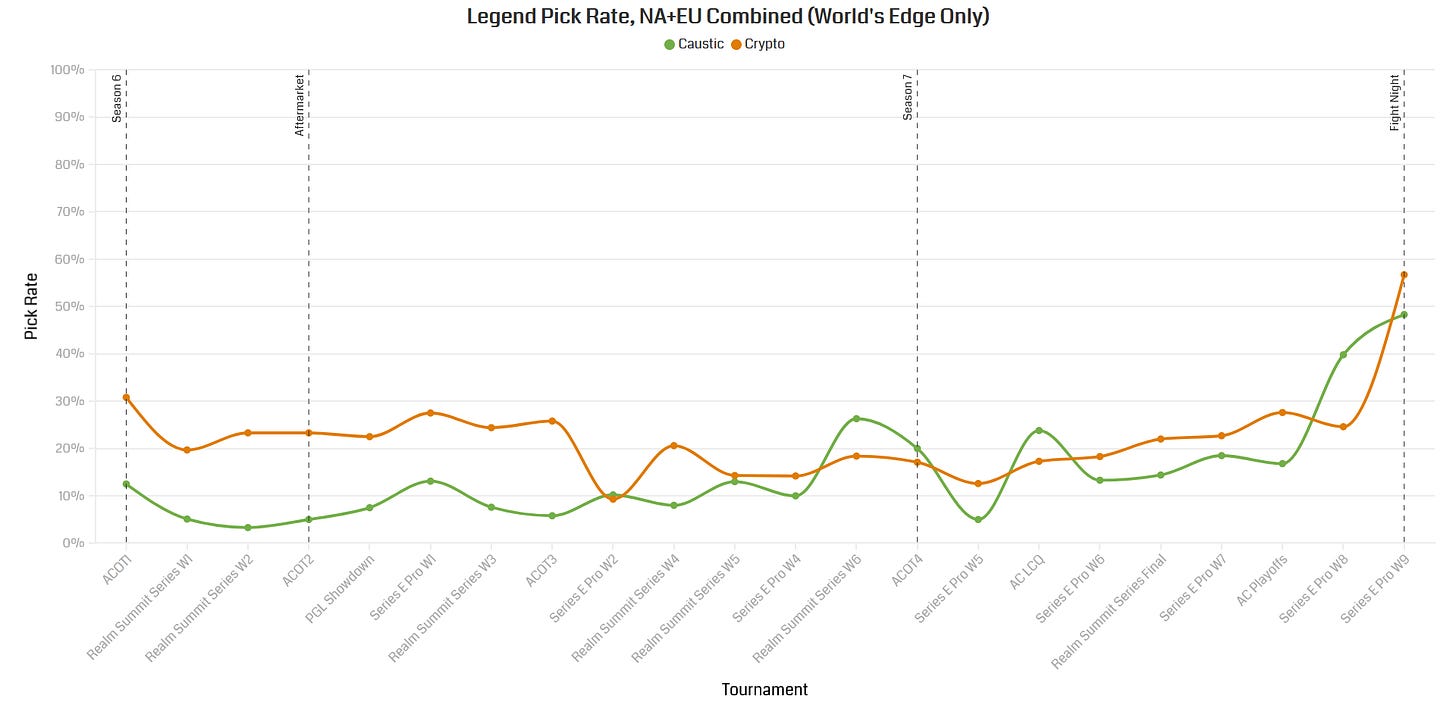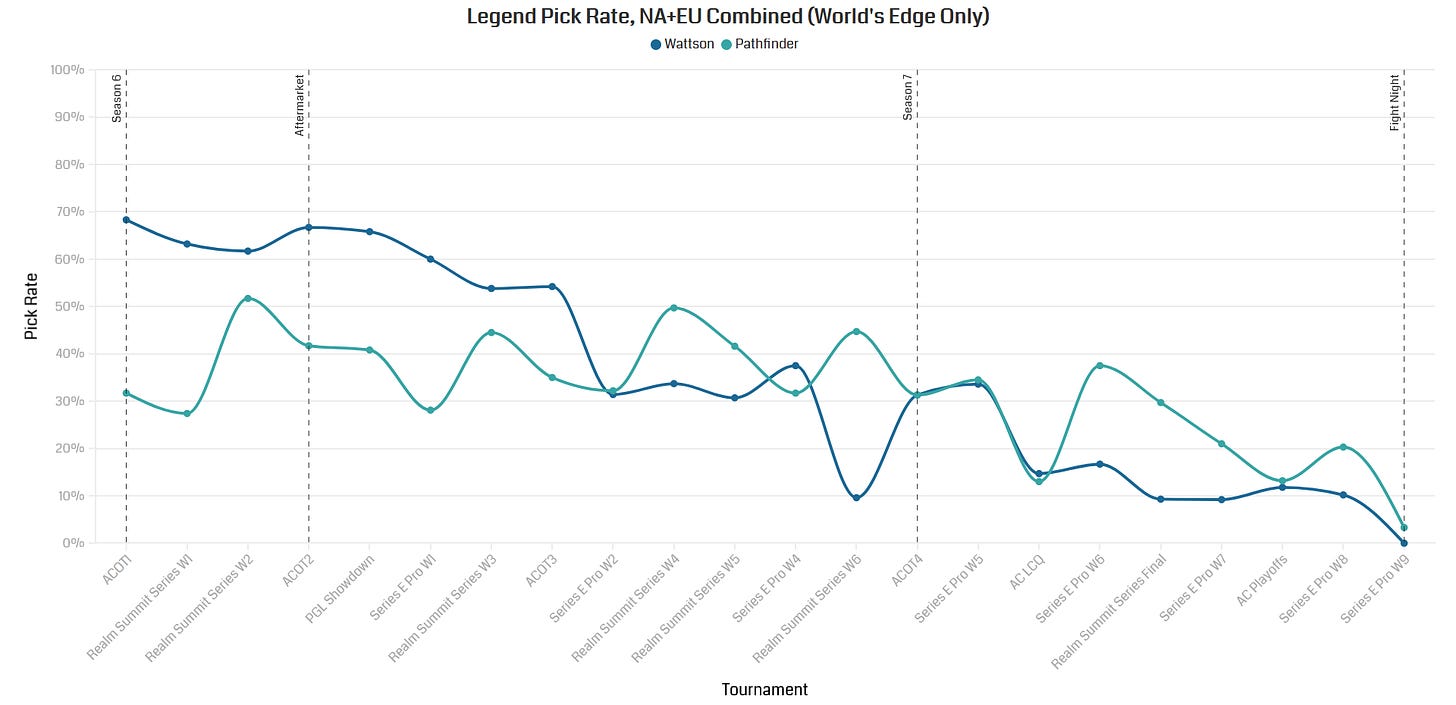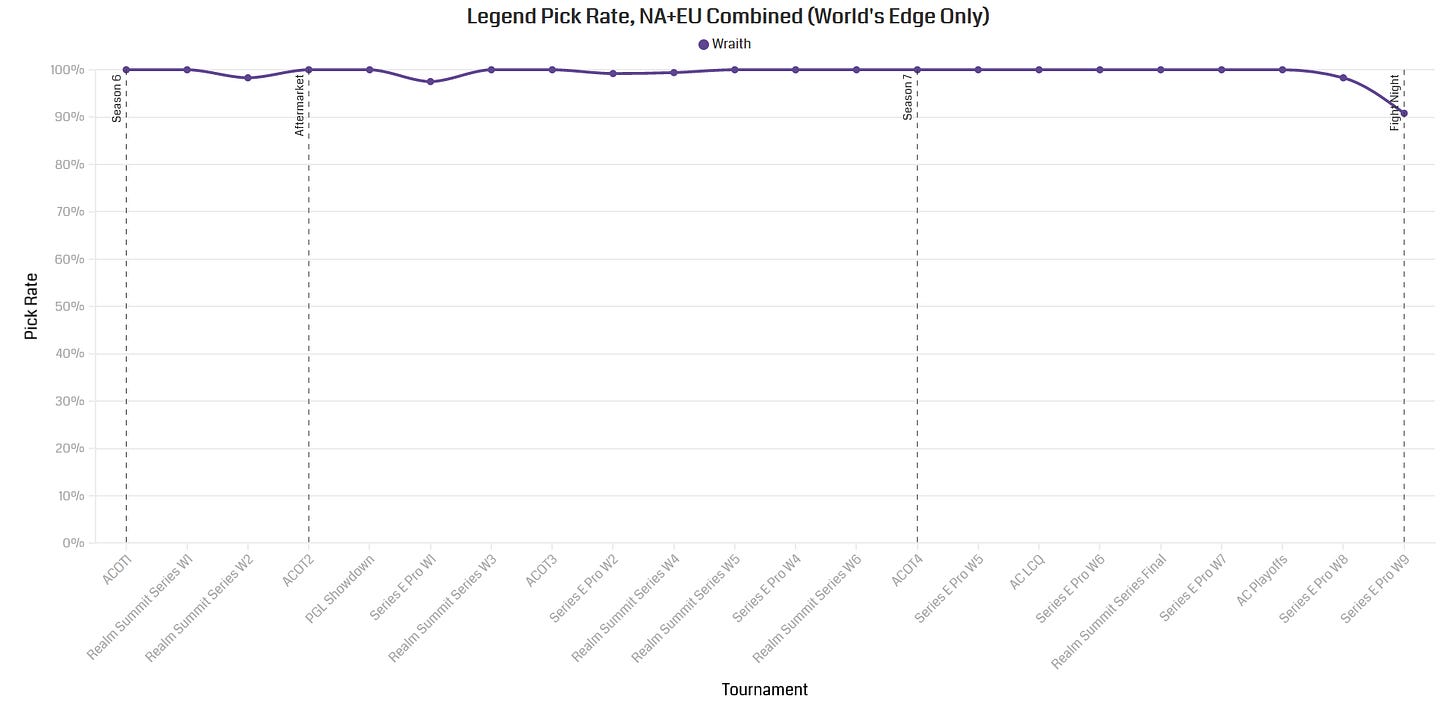The Singh Labs Winter Circuit Meta Preview
A newsletter for everyone in the competitive Apex community

In the lead-up to the first tournament of the Winter Circuit, frequent game crashes have continued to be a problem, frustrating pros and raising questions about competitive integrity. Initially, it seemed like players would just have to cross their fingers and hope they didn’t crash during the tournament. But yesterday, Zac Conely, the manager of the ALGS, stated on Twitter that the tournament may be postponed if the stability issues aren’t fixed by this weekend. As it stands, official broadcasts of the finals are scheduled for this Sunday, January 17th: APAC North at 6:00 PM JST, Europe at 5:45 PM GMT, and North America at 2:15 PM PST.
To find out we can expect to see in terms of gameplay this winter, I reached out to Singh Labs, who collects exhaustive pick rate data by hand to deliver high-quality analysis of the meta. They were generous enough to write up a guest post full of juicy data-supported meta analysis. Enjoy! And don’t forget to follow them on Twitter @ApexSinghLabs.
The Winter Circuit Meta Preview
Singh Labs
A new year is upon us, and with it comes a whole new circuit of competitive Apex to sink our teeth into. EA is upping the ante for the upcoming Winter Circuit, dishing out a total of $750,000 USD in prize money across all regions, up from the $500,000 prize pool made available for the Autumn Circuit. The extra purse, in most cases, means both an increase in prizes for the top-placing teams, and payouts being awarded further down the standings.
And if more cash at stake isn’t enough intrigue, the competitive scene also seems primed for a significant meta shift. With the Winter Circuit’s first online event set to kick off this weekend, let’s take a look at recent meta developments and what might be in store for players and viewers over the next few months in the North American and European regions.
A Change in the Making
If you’re looking to pinpoint what’s likely to be the most drastic change heading into Winter Circuit play, look no further than the usage of Caustic and Crypto. These two Legends are primed to make up a significant portion of most Winter Circuit lobbies, after spending the Autumn Circuit as relatively off-meta picks.
Both saw a gradual upward trend in pick rate leading into the Autumn Circuit Playoffs, with recent spikes seen in minor competitive play, such as the weekly Series E league and regular scrims. In Caustic’s case, this rise is despite him not actually receiving a further buff with the Fight Night patch, as previously covered by The Final Circle. It begs the question: what exactly in the game has led to this jump in popularity?
To answer this fully, we have to look back to Season 6. When the Autumn Circuit first kicked off, competitive Apex was relatively fresh into Season 6, with the Summer Circuit Playoffs being the only major tournament played on the new patch. Season 6 introduced two changes which would each prove to have major ripple effects on competitive play: Recon class Legend buffs, and a change in the ring logic algorithm. The former increased Bloodhound’s utility and gave both they and Crypto access to ring information through Survey Beacons, and the latter made predicting the “pull” of subsequent rings more difficult. As the Autumn Circuit went on, teams began to gravitate towards Gibraltar, as he enabled a playstyle suited to the unpredictability of the new ring logic.
Teams increasingly abandoned the old tried-and-true strategy of rotating as quickly as possible to game-winning areas, since predicting those game-winning areas suddenly became a much riskier proposition. Thanks to his bubble, Gibraltar offered teams a (quite literal) fighting chance when presented with unexpected rings requiring difficult rotations. His synergy with Bloodhound formed a formidable brawling composition, which ultimately came to be the Autumn Circuit’s meta-defining approach.
So, entering Season 7, competitive Apex now lives in a world with unpredictable zones and Wraith-Gibraltar-Bloodhound teams looking to fight their way through to safe positions. Enter Crypto: a Legend that provides both the most reliable method of gaining zone knowledge through his drone, and a hard counter to Gibraltar’s bubble through his EMP. What we’re seeing, then, with Crypto’s sharp rise in play, is the pendulum swinging back the other way — if the large majority of teams are focused on fighting around the edge of the ring, it means playing closer to the center for game-winning positions is more appealing. And it just so happens the Legend that’s best at providing the information needed to do that also poses a major threat to the Legend that enables the currently-dominant playstyle.
Where Caustic comes in is his complementary utility. Any team looking to hold down one of the strongest areas in the game needs some kind of defensive utility to discourage other teams from attempting to simply stroll up and roll them over. No option in Apex Legends comes close to Caustic in this regard, and he’s now fresh off a buff to his gas in Season 7, with the tick damage increased and its vision-blurring effect removed. What’s more, Caustic’s gas grenade ultimate remains extremely versatile, providing both survivability for teams caught in a rough spot, and enabling successful aggressive pushes when necessary.
It’s important to remember that meta changes are typically drawn-out affairs. It takes time for a player base to get used to changes in gameplay, evaluate options, and collectively determine what seems to be most viable. It took many major and minor events from the beginning of the Autumn Circuit for Gibraltar to regularly hit a mid-70 to high-80 percent pick rate, despite the game being largely unchanged over that time. A similar process is now playing out with Caustic and Crypto, with the Winter Circuit seemingly poised to capture this “boiling point” for the usage of both Legends.
Goodbye, Old Friends
A quick note here: readers familiar with competitive Apex gameplay of old might be wondering how we’ve made it this far into a meta discussion without mentioning Pathfinder & Wattson. This common duo could be in for quite the cold Winter Circuit, with their usage having dropped significantly over the Autumn Circuit, Wattson in particular.
Both are suffering from ripple effects of things mentioned above. In Wattson’s case, her defensive utility is outclassed by Caustic, hard-countered by Crypto’s EMP, and her ability to sustain a team’s shield economy through her ultimate is both threatened by the same EMP and rendered less vital than ever with the constant presence of Shield Batteries in Replicators, introduced with the Season 7 patch. As for Pathfinder, the amount of overall utility granted to Bloodhound and Crypto at the beginning of Season 6 has led to him gradually being considered a 2nd-class citizen among the Recon picks – especially with his ability to reach otherwise inaccessible high ground being less important on World’s Edge, the only map in the current competitive rotation, than on King’s Canyon.
A Whole New Endgame
One last change worth mentioning is the new behavior of the game’s final rings, introduced with the recent Fight Night patch. Ring 5 has been widened by an additional 33%, and Ring 6 is now the last ring. Rather than closing quickly into a tiny “pin drop” Ring 7 as in the past, the new Ring 6 will close quite slowly, over 100 seconds, and will consistently pull close to the center of Ring 5.
A change to the endgame dynamic has been a fairly common request from competitive players. Fighting for the win in the old Ring 7 was almost always a chaotic experience; a mess of abilities and bodies crowding out the tiny space and making the game’s climax both too confusing and luck-dependent. It was just as bad for spectators as well, who rarely had a hope of properly following what was going on until it was too late. Case in point: before updates were introduced to the game’s observer mode, it was a regular occurrence that even the casters themselves had no idea which team had just won the round due to all the confusion. As news of the change came out, many pro players voiced their resounding approval.


Besides looking forward to cleaner endgame fights, we also have to consider some potential impacts to the meta. Utility figures to be king here, particularly Legends that can pressure other teams without exposing themselves. Look for Caustic, Crypto, and Gibraltar ultimates to be devastating options. There’s even been some thought given to oddball picks – take Horizon, who could lift your team at the most crucial moment to relative safety, flying above the carnage below.
One possible knock-on effect that has seen some speculation is whether this might finally be the change to nudge Wraith off of her auto-pick status. Wraith has been a force in Apex since the beginning, commanding a 100% pick rate, or just barely below, through the entirety of the game’s competitive life.
And under the previous endgame ring system, she provided vital utility: her portal could be used to transition her whole team into Ring 7 to give them a fighting chance, or she could use her phase ability and repeatedly portal-hop as a stalling tactic while her teammates attempted to clear out the remaining enemies amidst the chaos. Now, however, with a slowly-closing final ring that no longer forces an immediate mad dash to the one safe location, teams will be able to play much more methodically. In most cases, this should eliminate the admittedly cheesy stalling maneuvers and reduce the necessity of portal plays. Make no mistake – Wraith’s rotational and scouting abilities remain unmatched, and most players are likely to stick with her due to her excellent early and mid-game value. But having even a couple teams per lobby bold enough to go for an endgame-focused Wraith-less composition – as we saw in the first minor tournament using the new rings, Series E Pro Week 9 – would represent a dip into uncharted waters for both Wraith and competitive Apex as a whole.
Huge thanks to Singh Labs for their amazing work. Give them a follow @ApexSinghLabs for more high-quality content. As The Final Circle grows, I’d like to do more guest posts like this, so if you have a great Apex take that no one’s talking about, reach out to me @UR_Scrubb or leave a comment. And if you like this work and want to support independent coverage of the Apex scene, subscribe!
Next week, we’ll take a look at the possible return of LAN with the announcement of the $1,000,000 prize pool ALGS Championship, as well as debrief about this weekend’s tournament, bugs and stability issues, and the recent swattings of several streamers in the Apex community.








